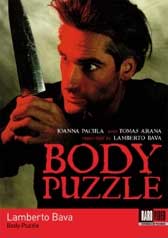 BODY
PUZZLE (1992)
BODY
PUZZLE (1992)Director: Lamberto Bava
Raro Video/eOne
 BODY
PUZZLE (1992)
BODY
PUZZLE (1992)A classical music-loving psychopathic killer is carving up Roman citizens and leaving grisly presents for a smoking-hot young widow in Lamberto Bava’s 1990s giallo BODY PUZZLE (back on DVD from Raro Video).
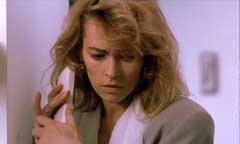
An affable-looking psychopath (François Montagut, DANGEROUS LIAISONS) brutally murders a candy shop proprietor and takes some souvenir body parts with him. Jaded cop Michael Livet (Tomas Arana, GLADIATOR) isn’t the least surprised, until the dead man’s ear turns up gift-wrapped in the refrigerator of recently-widowed Tracy Grant (Joanna Pacula, THE KISS). Although the connection isn’t clear to Livet, it seems doubly strange that she should be the recipient of this morbid gift after having discovered that her husband Abe’s grave has been robbed. Since the killer was able to get in and out of her townhouse without being noticed, Livet is adamant that Tracy stay somewhere else. Tracy and her dog Bo head out to her family’s country house where she will be alone since her parents are out of the country. When a woman is gruesomely murdered in a shopping mall bathroom and her severed hand shows up at Tracy’s doorstep, the connection between the murders and Abe’s missing corpse is undeniable. Leaving flunky partner Jimmy (Matteo Gazzolo, SPECTERS) to watch over Tracy, Livet starts looking into Abe’s private life and discovers that he kept a room for homosexual encounters at the stables belonging to wealthy Guy Morangi (Giovanni Lombardo Radice, THE HOUSE ON THE EDGE OF THE PARK), who was the one to identify Abe’s body. In Abe’s room, Livet finds a photograph of Abe and another man as well as a hidden address book. The only number that does not lead to a pay phone is that of psychiatrist Emily Worthing (Erika Blanc, THE DEVIL’S NIGHTMARE), who tells him that Abe asked her to treat a friend named Tim Bell who did not handle his marriage to Tracy at all well. When another murder occurs and Tracy receives another bloody present – quite an unkind cut (“It’s not a finger”) – and Livet finds out that Abe’s organs were donated after his death, he realizes that Abe’s unstable friend/possible lover is piecing Abe back together and there are more victims on the list (this, being somewhat of a giallo – and definitely a modern thriller of absurd one-upsy twists, means that there is even more to the solution).
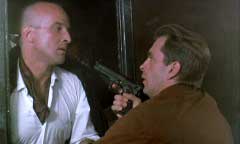 BODY
PUZZLE was one of a handful of P.A.C. productions from the 1990s after a somewhat
spotty 1980s output – seemingly with the home video market in mind –
from a couple seasoned directors (most of which were picked up for DVD by Madacy)
including Sergio Sollima’s BERLIN ’39, Stelvio Massi’s HIGH
RISK and BALKAN RUNNER (as well as Danilo Massi’s WAR DOGS), Mauro Bolognini’s
HUSBANDS AND LOVERS (with Pacula and the same swanky townhouse seen in this
film), and Carlo Lizzani’s CATTIVA. Aldo Lado’s disappointly derivative
CIRCLE OF FEAR (ALIBI PERFETTO) – also blandly photographed by Kuveiller
– with Michael Woods (LADY BEWARE) and Annie Girardot (THE PIANO TEACHER)
was the only other giallo-esque title; although, that film owed more to SILENCE
OF THE LAMBS than anything Italian or even the more staid whodunits (Lado also
helmed the bland-looking POWER AND LOVERS – with Stephen Dillane [KLIMT]
and Jemma Redgrave [DREAM DEMON] for P.A.C.). The Italian version credits the
story to Teodoro Agrimi (who scripted Mario Bava’s FIVE DOLLS FOR AN AUGUST
MOON for P.A.C., and was also production manager on this film) and Domenico
Paolella (director of THE STORY OF A CLOISTERED NUN and THE NUNS OF SAINT ARCHANGEL
[the other film released on US videotape as SISTERS OF SATAN]), while the script
is credited to Agrimi, Paolella, and Bruce Martin (his only credit). I’m
assuming that Martin was responsible for the English dialogue – the film
was acted on-set in English – since he receives sole scripting credit
in the English credits sequence. The story seems more derivative of Michael
Apted’s bland BLINK than Eric Red’s nuttier BODY PARTS (adapted
from the 1965 novel CHOICE CUTS by Boileau-Narcejac, better known for the source
novels of LES DIABOLIQUES and VERTIGO). It’s tempting to think that Agrimi
and Paolella’s scenario dated from an earlier attempt to unofficially
adapt the Boileau-Narcejac novel – a planned 1967 American adaptation
by producer Arthur P. Jacobs (PLANET OF THE APES) was abandoned – but
the two also wrote a couple of the other P.A.C. nineties films mentioned above.
BODY
PUZZLE was one of a handful of P.A.C. productions from the 1990s after a somewhat
spotty 1980s output – seemingly with the home video market in mind –
from a couple seasoned directors (most of which were picked up for DVD by Madacy)
including Sergio Sollima’s BERLIN ’39, Stelvio Massi’s HIGH
RISK and BALKAN RUNNER (as well as Danilo Massi’s WAR DOGS), Mauro Bolognini’s
HUSBANDS AND LOVERS (with Pacula and the same swanky townhouse seen in this
film), and Carlo Lizzani’s CATTIVA. Aldo Lado’s disappointly derivative
CIRCLE OF FEAR (ALIBI PERFETTO) – also blandly photographed by Kuveiller
– with Michael Woods (LADY BEWARE) and Annie Girardot (THE PIANO TEACHER)
was the only other giallo-esque title; although, that film owed more to SILENCE
OF THE LAMBS than anything Italian or even the more staid whodunits (Lado also
helmed the bland-looking POWER AND LOVERS – with Stephen Dillane [KLIMT]
and Jemma Redgrave [DREAM DEMON] for P.A.C.). The Italian version credits the
story to Teodoro Agrimi (who scripted Mario Bava’s FIVE DOLLS FOR AN AUGUST
MOON for P.A.C., and was also production manager on this film) and Domenico
Paolella (director of THE STORY OF A CLOISTERED NUN and THE NUNS OF SAINT ARCHANGEL
[the other film released on US videotape as SISTERS OF SATAN]), while the script
is credited to Agrimi, Paolella, and Bruce Martin (his only credit). I’m
assuming that Martin was responsible for the English dialogue – the film
was acted on-set in English – since he receives sole scripting credit
in the English credits sequence. The story seems more derivative of Michael
Apted’s bland BLINK than Eric Red’s nuttier BODY PARTS (adapted
from the 1965 novel CHOICE CUTS by Boileau-Narcejac, better known for the source
novels of LES DIABOLIQUES and VERTIGO). It’s tempting to think that Agrimi
and Paolella’s scenario dated from an earlier attempt to unofficially
adapt the Boileau-Narcejac novel – a planned 1967 American adaptation
by producer Arthur P. Jacobs (PLANET OF THE APES) was abandoned – but
the two also wrote a couple of the other P.A.C. nineties films mentioned above.
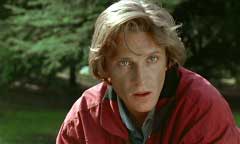
The murders were originally scored with the over-used but effective “O Fortuna” from Carl Orff’s CARMINA BURANA, but the composer’s heirs objected – although they don’t mind the piece being used in razor commercials and trailers for crappy action films – and it was replaced with the even more overused “Night on Bald Mountain” by Mussorgsky (if you’re not a classical music aficionado, please refer to the opening title sequence of the Amicus anthology ASYLUM). The end credits of the English versions still cite the Orff cue, although some VHS and DVD versions cut away early to character disclaimer to cover up the credit. During the murder of teacher Kate (Ursula von Baechler) before a class of blind children, Bava layers the soundtrack with both the Mussorgsky piece – timed reasonably well to coincide with the action – and also the tape recording of a story version of “Peter and the Wolf” with the murder coinciding with the attack of the wolf. The Mussorgsky piece is also a workable substitute for a JAWS-esque theme as the killer swims underwater with a butcher knife aimed towards his intended victim (Francesco Romano, THE RAINBOW THIEF). The onscreen depiction of violence, however, is rather restrained (with the exception of a nasty amputation by hatchet, which is unexpected in its onscreen depiction and falsely gears viewers up for escalating graphic gore [a jump in the Mussorgsky soundtrack during a later murder suggests that a graphic bit may have been lopped out after the rescoring, but the English and Italian versions are the same]). The relationship between Livet and Tracy is rather forced and they seem to fall into bed at the most convenient moment pacing-wise; however, we (and Arana) get to see Pacula in a bikini and skimpy lingerie. Tracy’s explanation for not getting out of the country until the case blows over is both clichéd and nonsensical: “I spent a lot of time running away from things […] This time I’m staying. Whoever it is, what ever they want, they won’t make me run” (Really, Tracy? You’ve got an organ-ripping, body part-severing killer stalking you, and this is where you take your stand?). There are some needless obligatory bits such as a couple scenes with Livet’s PR-conscious chief; however, they allow for a guest appearance by another Italian horror vet: Gianni Garko (COLD EYES OF FEAR) who gets to say “I kiss ass one day, and I kick ass the next.” There’s also a medical examiner named “Mort” (TV actor Sebastiano Lo Monaco) who eats his lunch surrounded by autopsied cadavers, and says stuff like “Could be you’ve got yourself a real psychopath here.” The cemetery director (Gianni Guiliano) also introduces himself as “Mario Fulci” (Giuliano not only served as Italian dubbing director on a couple of Lamberto Bava’s films from this period, he also supervised the Italian dubbing of Lucio Fulci’s THE DEVIL’S HONEY). SPOILER: the final shot is also a bit nonsensical with Livet sending Tracy home so he can finish up the investigation, only to then walk away from the crime scene and into the horizon for the high-angle closing shot.
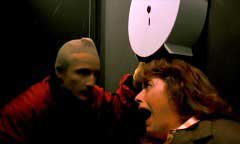
The great Luigi Kuveiller – who expertly lensed Dario Argento’s DEEP RED and Lucio Fulci’s LIZARD IN A WOMAN’S SKIN and NEW YORK RIPPER – gives the film a slick-yet-bland TV-movie look with none of the adventurous camera moves, cubist compositions, or garish gel lighting of his earlier gialli; there are, however, some a handful of attractively lit and composed shots. The make-up effects of Franco Casagni (THE STENDHAL SYNDROME) are mostly bloodless prosthetic body parts – other than the severed hand bit – and are nowhere near as showy as his work on OPERA (in collaboration with Rosario Prestopino [PHENOMENA]). Bava regular Piero Bozza (DEMONS) fares better, but even his rhythmic editing is compromised by the change from Orff to Mussorgsky during the murder sequences. Carlo Maria Cordio’s score is rather generic erotic thriller keyboards, piano, and sax; given the song change, it is just as well that Cordio incorporates Bach’s “Jesu, Joy of Man’s Desiring” – the piece Montagut is listening to during the opening credits – as a motif rather than the Orff composition. The sets were designed by another Argento alumnus: Davide Bassan (OPERA), son of Giuseppe Bassan (SUSPIRIA). Arana does what he can, but manages only to inject a touch of insolence to a cliché cynical detective. The American actor stopped off in Italy to play Lazarus in Martin Scorcese’s THE LAST TEMPTATION OF CHRIST and picked up some prominent roles in Italian exploitation, including showier parts like the Satanic hotel porter of Beppe Cino’s 9 1/2 WEEKS rip-off INTIMO (with Eva Grimaldi), the possessed librarian/amateur archeologist of Michele Soavi’s THE CHURCH, and the Manson-esque devil worshipping hippie serial killer in Soavi’s THE SECT. Pacula pouts a lot – and looks great doing it – but it’s her accent that makes the dialogue sound more interesting than it is (the fact that Pacula – still hot today – has been cast as Ruth Madoff in a movie about Bernie Madoff suggests that the filmmakers are taking some major liberties). Montagut is a blank slate throughout the film, but that’s kind of required of his character (he’s a prolific stage and film actor so I’ll chalk it up to the demands of the role). With the exception of Radice (who reacts to an exclamation of “Jesus” with “You flatter me. At the most, a fallen angel”) and gets a great low-angle introductory shot, most of the supporting cast makes little impression; however, there are some welcome faces among them like Blanc, Garko, and Bruno Corazzari (THE BLACK CAT) as a mental hospital director. Italian actor Silvano Tranquili (THE HORRIBLE DR. HICHCOCK) supervised the dubbing of the Italian version, while dubbing regular Nick Alexander (who also dubbed Corazzari) supervised the English track.
 BODY
PUZZLE has had a rather muddled release history. The U.S. rights were picked
up by the short-lived Triboro Entertainment label (who also released shortened
– though not censored – “unrated” versions of ANDY WARHOL’S
DRACULA and ANDY WARHOL’S FRANKENSTEIN, as well as a slightly shortened
NC-17 cut of the already shorter international version of TOKYO DECADENCE, and
several DTV erotic thrillers and action flicks), who released an uncut, open-matte
transfer. The screener cassettes reportedly retained the film’s original
opening titles and stereo soundtrack, while the rental tapes made use of a credit-less
version of the opening sequence (other than the title card) with video-generated
credits referring to Arana as “Tom Aaron”, Montagut as “Frank
Quinn”, cinematographer Kuveiller as “Lee Kraus” and Bava
as “Larry Louis” (it seems that Triboro were not in on the “John
M. Old Jr.” joke). The soundtrack was reportedly also mixed down to mono
(Image Entertainment released the film for Triboro on laserdisc, reportedly
with digital and analog mono tracks). In the late 1990s, Triboro’s catalogue
and masters were acquired by FCP Media Ventures, who re-licensed the film (and
some other Triboro titles) to Image for DVD. That progressive-scanned transfer
was the same uncut, open-matte version with the original opening credits and
restored stereo sound (although the back cover featured a mono Dolby Digital
diagram and still used all of the pseudonyms, suggesting that Image didn’t
know what they had). A few years later, Madacy Entertainment re-released the
film on DVD utilizing a newer 1.66:1 non-anamorphic widescreen master provided
by Liberty Entertainment; however, it was a PAL-NTSC transfer (the same master
also popped up on Dutch DVD with the stereo track cheaply upmixed to 5.1 Dolby
Digital and DTS configurations). The film was released twice in Italy under
the MISTERIA title: first by Prism Entertainment, and then by Flamingo Video
(a sub-label of Cecchi Gori Home Video). I have only seen the latter version,
and that disc featured an anamorphic 1.66:1 transfer in Italian Dolby Digital
2.0 stereo; however, the image was soft and riddled with black speckling. The
image was warmer, brighter, and less blue than the Image transfer, which looked
appropriately moody; however, the warmer transfer gives a Rembrandt-esque look
to some of the low-lit interiors without blowing out the brighter scenes. While
the transfer bore the reissue title, it was fairly complete save for roughly
a minute and a half of footage largely comprised of three cuts to the scene
in which Livet first interviews Guy and visits the stables (less than twenty
seconds were also trimmed from the end of the swimming pool murder, but that
was always gore-less). The cuts made very little sense, and were possibly last
minute trims to the original Italian release version. At PAL speed, this version
ran 93:21 seconds while the Dutch disc ran 94:48.
BODY
PUZZLE has had a rather muddled release history. The U.S. rights were picked
up by the short-lived Triboro Entertainment label (who also released shortened
– though not censored – “unrated” versions of ANDY WARHOL’S
DRACULA and ANDY WARHOL’S FRANKENSTEIN, as well as a slightly shortened
NC-17 cut of the already shorter international version of TOKYO DECADENCE, and
several DTV erotic thrillers and action flicks), who released an uncut, open-matte
transfer. The screener cassettes reportedly retained the film’s original
opening titles and stereo soundtrack, while the rental tapes made use of a credit-less
version of the opening sequence (other than the title card) with video-generated
credits referring to Arana as “Tom Aaron”, Montagut as “Frank
Quinn”, cinematographer Kuveiller as “Lee Kraus” and Bava
as “Larry Louis” (it seems that Triboro were not in on the “John
M. Old Jr.” joke). The soundtrack was reportedly also mixed down to mono
(Image Entertainment released the film for Triboro on laserdisc, reportedly
with digital and analog mono tracks). In the late 1990s, Triboro’s catalogue
and masters were acquired by FCP Media Ventures, who re-licensed the film (and
some other Triboro titles) to Image for DVD. That progressive-scanned transfer
was the same uncut, open-matte version with the original opening credits and
restored stereo sound (although the back cover featured a mono Dolby Digital
diagram and still used all of the pseudonyms, suggesting that Image didn’t
know what they had). A few years later, Madacy Entertainment re-released the
film on DVD utilizing a newer 1.66:1 non-anamorphic widescreen master provided
by Liberty Entertainment; however, it was a PAL-NTSC transfer (the same master
also popped up on Dutch DVD with the stereo track cheaply upmixed to 5.1 Dolby
Digital and DTS configurations). The film was released twice in Italy under
the MISTERIA title: first by Prism Entertainment, and then by Flamingo Video
(a sub-label of Cecchi Gori Home Video). I have only seen the latter version,
and that disc featured an anamorphic 1.66:1 transfer in Italian Dolby Digital
2.0 stereo; however, the image was soft and riddled with black speckling. The
image was warmer, brighter, and less blue than the Image transfer, which looked
appropriately moody; however, the warmer transfer gives a Rembrandt-esque look
to some of the low-lit interiors without blowing out the brighter scenes. While
the transfer bore the reissue title, it was fairly complete save for roughly
a minute and a half of footage largely comprised of three cuts to the scene
in which Livet first interviews Guy and visits the stables (less than twenty
seconds were also trimmed from the end of the swimming pool murder, but that
was always gore-less). The cuts made very little sense, and were possibly last
minute trims to the original Italian release version. At PAL speed, this version
ran 93:21 seconds while the Dutch disc ran 94:48.
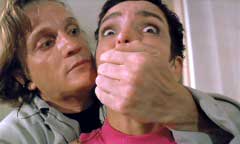 Despite
concerns that Raro’s new anamorphic, progressive, single-layer transfer
might not be complete since they would be utilizing Italian materials, the resulting
disc runs 98:30 (the Image disc ran 98:21). The new transfer is a definite improvement.
It is still somewhat soft, but sharper than the Italian transfer and the black
speckling is gone. The color and contrast levels match those of the Italian
transfer. The English Dolby Digital 2.0 stereo track has some faint hiss. The
dubbed dialogue is a little low but always understandable (the dialogue scenes
between Pacula and Arana – possibly recorded live – are clearer),
while the music and effects are mixed louder. Raro has unfortunately not included
the Italian track and optional English subtitles one has come to expect from
their past releases – possibly due to the shorter timing of the Italian
version – but the English track features the voices of Pacula and Arana.
The release seems marked by a degree of editorial carelessness. The back cover
not only promises Italian audio with English subtitles, but also non-existent
“New and improved English subtitles” (and no previous subtitled
releases to improve upon). Pacula’s name is misspelled as “Johanna
Pakula,” Agrimi – listed with his real surname Corra – has
his first name misspelled as “Todoro” and one “L” is
dropped from Kuveiller’s name. Disappointingly – and bewilderingly
– the only extra on the DVD is a screen of disc production credits; however,
a small booklet features a four-page essay on the film by Fangoria
editor Chris Alexander and a two-page Lamberto Bava biography by Mark Patay
(and a filmography on the back cover). (Eric
Cotenas)
Despite
concerns that Raro’s new anamorphic, progressive, single-layer transfer
might not be complete since they would be utilizing Italian materials, the resulting
disc runs 98:30 (the Image disc ran 98:21). The new transfer is a definite improvement.
It is still somewhat soft, but sharper than the Italian transfer and the black
speckling is gone. The color and contrast levels match those of the Italian
transfer. The English Dolby Digital 2.0 stereo track has some faint hiss. The
dubbed dialogue is a little low but always understandable (the dialogue scenes
between Pacula and Arana – possibly recorded live – are clearer),
while the music and effects are mixed louder. Raro has unfortunately not included
the Italian track and optional English subtitles one has come to expect from
their past releases – possibly due to the shorter timing of the Italian
version – but the English track features the voices of Pacula and Arana.
The release seems marked by a degree of editorial carelessness. The back cover
not only promises Italian audio with English subtitles, but also non-existent
“New and improved English subtitles” (and no previous subtitled
releases to improve upon). Pacula’s name is misspelled as “Johanna
Pakula,” Agrimi – listed with his real surname Corra – has
his first name misspelled as “Todoro” and one “L” is
dropped from Kuveiller’s name. Disappointingly – and bewilderingly
– the only extra on the DVD is a screen of disc production credits; however,
a small booklet features a four-page essay on the film by Fangoria
editor Chris Alexander and a two-page Lamberto Bava biography by Mark Patay
(and a filmography on the back cover). (Eric
Cotenas)